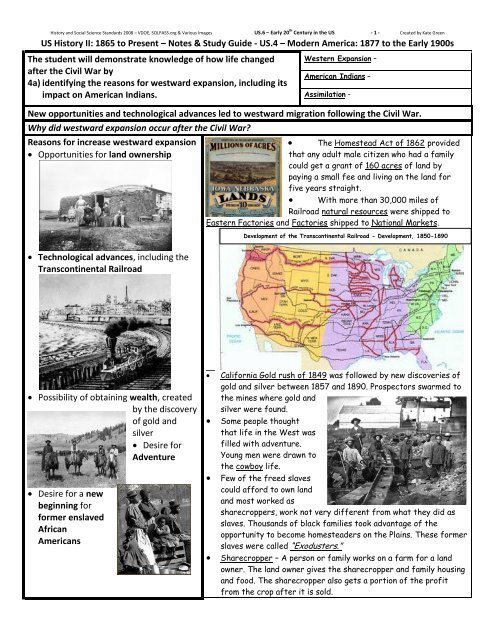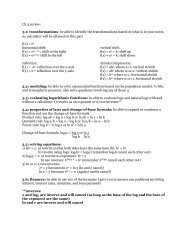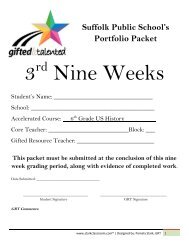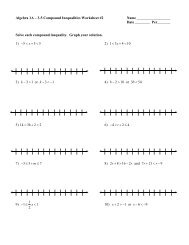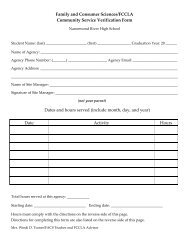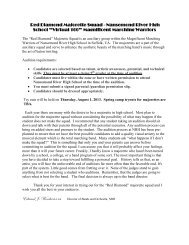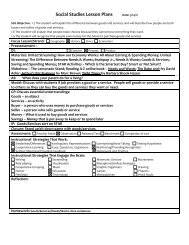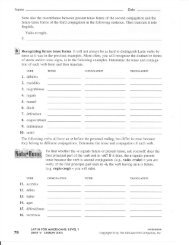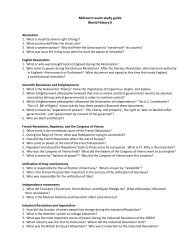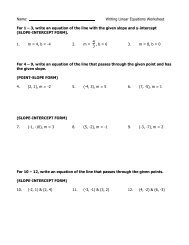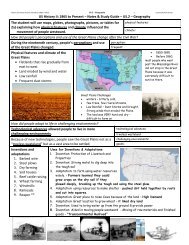US History II: 1865 to Present â Notes & Study Guide - US.4 ...
US History II: 1865 to Present â Notes & Study Guide - US.4 ...
US History II: 1865 to Present â Notes & Study Guide - US.4 ...
Create successful ePaper yourself
Turn your PDF publications into a flip-book with our unique Google optimized e-Paper software.
<strong>His<strong>to</strong>ry</strong> and Social Science Standards 2008 – VDOE, SOLPASS.org & Various Images <strong>US</strong>.6 – Early 20 th Century in the <strong>US</strong> - 1 - Created by Kate Green<strong>US</strong> <strong>His<strong>to</strong>ry</strong> <strong>II</strong>: <strong>1865</strong> <strong>to</strong> <strong>Present</strong> – <strong>Notes</strong> & <strong>Study</strong> <strong>Guide</strong> - <strong>US</strong>.4 – Modern America: 1877 <strong>to</strong> the Early 1900sThe student will demonstrate knowledge of how life changedafter the Civil War by4a) identifying the reasons for westward expansion, including itsimpact on American Indians.Western Expansion –American Indians –Assimilation –New opportunities and technological advances led <strong>to</strong> westward migration following the Civil War.Why did westward expansion occur after the Civil War?Reasons for increase westward expansion Opportunities for land ownershipThe Homestead Act of 1862 providedthat any adult male citizen who had a familycould get a grant of 160 acres of land bypaying a small fee and living on the land forfive years straight.With more than 30,000 miles ofRailroad natural resources were shipped <strong>to</strong>Eastern Fac<strong>to</strong>ries and Fac<strong>to</strong>ries shipped <strong>to</strong> National Markets.Development of the Transcontinental Railroad - Development, 1850-1890 Technological advances, including theTranscontinental Railroad Possibility of obtaining wealth, createdby the discoveryof gold andsilver Desire forAdventure Desire for a newbeginning forformer enslavedAfricanAmericansCalifornia Gold rush of 1849 was followed by new discoveries ofgold and silver between 1857 and 1890. Prospec<strong>to</strong>rs swarmed <strong>to</strong>the mines where gold andsilver were found.Some people thoughtthat life in the West wasfilled with adventure.Young men were drawn <strong>to</strong>the cowboy life.Few of the freed slavescould afford <strong>to</strong> own landand most worked assharecroppers, work not very different from what they did asslaves. Thousands of black families <strong>to</strong>ok advantage of theopportunity <strong>to</strong> become homesteaders on the Plains. These formerslaves were called “Exodusters.”Sharecropper – A person or family works on a farm for a landowner. The land owner gives the sharecropper and family housingand food. The sharecropper also gets a portion of the profitfrom the crop after it is sold.
<strong>His<strong>to</strong>ry</strong> and Social Science Standards 2008 – VDOE, SOLPASS.org & Various Images <strong>US</strong>.6 – Early 20 th Century in the <strong>US</strong> - 2 - Created by Kate GreenHow did the lives of American Indians change with western expansion?NativeAmericanBeliefs aboutLandIndians believed that land and its resources should be available <strong>to</strong> all, and not something that could be bough<strong>to</strong>r sold. Buffalo had provided the Indians of the Plains with most of their needs, but by 1883, buffalo werenearly extinct. Whites killed buffalo for meat, hides, and increasingly for sport. Buffalo, which in the pasthad roamed and grazed on the plains at will, were cut off from grazing land by barbed wire fences.Impact on American Indians Opposition by American Indians <strong>to</strong>westward expansion (Battle of LittleBighorn, Sitting Bull, Geronimo)Forced relocation from traditional lands<strong>to</strong> reservations (Chief Joseph, NezPercé) Reduced population through warfareand disease (Battle of Wounded Knee) Assimilation attempts and lifestylechanges (e.g., reduction of buffalopopulation) Reduced their homelands throughtreaties that were brokenGeronimo was an Apacheleader in the Southwest,who is known fordefending his tribeagainst the Mexicans andUnited States Calvary formost of his life. He was very Adventurous,Brave and Daring in his exploits and escapedcapture by the <strong>US</strong> for more than 30 years. By <strong>1865</strong>, Indians and whites had frequent conflictson the Great Plains and throughout the Southwestand Northwest. In 1867 a Peace Commission waswritten <strong>to</strong> convince the tribes <strong>to</strong> give up theirlands and <strong>to</strong> relocate on<strong>to</strong> "reservations" - tractsof land set aside for Indiancommunities. Some Indians moved Battle of Little Bighornwillingly, while others continued <strong>to</strong>fight for their land and their wayof life. Battle of Little Bighorn - In1876, the federal governmenttried <strong>to</strong> force the Lakota, led byCrazy Horse and Sitting Bull inthe Midwest (Great Plains), back on <strong>to</strong> the reservation.General George Custer led his troops against morethan 2,000 Lakota Indians. Custer and all of his mendied in that attack, which came <strong>to</strong> be known as"Custer's Last Stand." The Lakota were joyous bytheir vic<strong>to</strong>ry, but within a few months they were forced <strong>to</strong> surrender. In 1877, when the federal government sent troops in<strong>to</strong> force the Nez Percé tribe off their lands in theWashing<strong>to</strong>n terri<strong>to</strong>ry (Northeast) and on<strong>to</strong> a reservation,Chief Joseph led 400,000 of his people on a long walk<strong>to</strong>ward the Canadian border <strong>to</strong> escape white settlers andtroops. With only a few miles left <strong>to</strong> Canada, the troopscaptured Chief Joseph and his warriors, the old people,the women, the children, and sent them off <strong>to</strong> IndianTerri<strong>to</strong>ry. Chief Joseph was sent <strong>to</strong> a separate reservation. December 29, 1890, a Lakota tribe living in South Dakota, near a creekcalled Wounded Knee, was being disarmed by the <strong>US</strong> Calvary. A deafnative was not willing <strong>to</strong> give up his gun and a shot was fired accidentally.The Calvary began firing randomly at the tribe’s people, killing Men,Women and Children. Their own soldiers were killed and injured also.The surviving Lakota fled, but U.S. cavalrymen pursued and killed manywho were unarmed. By the time it was over, at least 150 men, women,and children of the Lakota hadbeen killed and 51 wounded (4Battle of Wounded Kneemen, 47 women and children,some of whom died later); someestimates placed the numberof dead at 300. Twenty-fivetroopers also died, and 39 werewounded (6 of the woundedwould later die).
<strong>His<strong>to</strong>ry</strong> and Social Science Standards 2008 – VDOE, SOLPASS.org & Various Images <strong>US</strong>.6 – Early 20 th Century in the <strong>US</strong> - 3 - Created by Kate GreenWHO?________________________WHO?________________________WHO?________________________WHO?________________________
<strong>His<strong>to</strong>ry</strong> and Social Science Standards 2008 – VDOE, SOLPASS.org & Various Images <strong>US</strong>.6 – Early 20 th Century in the <strong>US</strong> - 4 - Created by Kate GreenThe student will demonstrate knowledge of how lifechanged after the Civil War by4b) explaining the reasons for the increase inimmigration, growth of cities, and challengesarising from this expansion.Immigration – Specialized Industry –Challenges – Tenements –Cultural Groups – Settlement Houses -Population changes, growth of cities, and newinventions produced interaction and oftenconflict between different cultural groups.Population changes, growth of cities, and newinventions produced problems in urban areas.Why did immigration increase?Reasons for the increase inimmigration Hope for better opportunities Desire for religious freedom Escape from oppressivegovernments Desire for adventureWhy did cities grow and develop?Urban – Political Machines –Rural –Reasons why cities grew and developed Specialized industries, including steel (Pittsburgh) and meatpacking (Chicago) In the 1840s, the pota<strong>to</strong> crop failed and Irish farmers had nothing <strong>to</strong>eat. By 1860 Irish immigrants had largely replaced the New England millgirls as textile workers. (Took their jobs) From 1860 <strong>to</strong> 1910, the U.S. population tripled. After 1880, immigrantswere often from southern and eastern Europe, where there was littleindustry and life was hard for poor peasants. Before they came fromWestern and Northern Europe. Jewish from Eastern Europe fled because of religious persecution.(Religious Persecution) Russians and Polish escaped political oppression at home. (OppressiveGovernment) Industrial expansion created jobs thatattracted thousands of immigrants <strong>to</strong>America. This was the beginning of a vast migrationfrom the farms <strong>to</strong> the cities whenagricultural machinery cut the need forfarm laborers. Mechanization Immigration <strong>to</strong> America from other countries Movement of Americans from rural <strong>to</strong> urban areas for jobopportunities The Reaper did the work of 10 men, 9moved <strong>to</strong> industrial cities.
<strong>His<strong>to</strong>ry</strong> and Social Science Standards 2008 – VDOE, SOLPASS.org & Various Images <strong>US</strong>.6 – Early 20 th Century in the <strong>US</strong> - 5 - Created by Kate GreenWhat challenges faced Americans as a result of these social and technological changes?Rapid industrialization andurbanization led <strong>to</strong>overcrowded immigrantneighborhoods andtenements.Efforts <strong>to</strong> solve immigrationproblems Settlementhouses, suchas Hull Housefounded byJane Addams Politicalmachines that gained power by attending <strong>to</strong>the needs of new immigrants (e.g., jobs,housing)Overcrowding causedfrequent epidemics oftyphoid, smallpox, andtuberculosis. Bad water andgarbage in the streets led<strong>to</strong> disease. The ghet<strong>to</strong>swere filled with smoke anddust. The crime rate was high. Fires were frequent.Hull House in Chicago, IL was established <strong>to</strong> helpimmigrants. It providedmany services - fromkindergartens <strong>to</strong> laundryrooms. Other settlementhouses soon opened aroundthe nation. (e.g., jobs,housing)Progressives fought the power of the bosses and the political machines that controlled the big cities. By 1900 city lifebecoming better. Fresh water was piped in, lighting was installed. Some city bosses tried <strong>to</strong> help new immigrants in order <strong>to</strong>get their votes. Many attempts <strong>to</strong> reform the city machines. Reformers created city-owned services like garbage collectionsand street cleaning, and also created private organizations <strong>to</strong> help the poor.Discrimination against immigrants Chinese Irish Settlers on the West Coastespecially blamed decliningwages and economic problemson the Chinese workers. In 1882, Congress passed theChinese Exclusion Act, thefirst significant law restricting immigration in<strong>to</strong>the United States. The Irish began <strong>to</strong> arrive in large numbers, by the1840s after the pota<strong>to</strong> crop failed. By 1860 Irish immigrants had largely replaced theNew England mill girls as textile workers. Americans tended <strong>to</strong> look down on each group of newimmigrants. Immigrants in turn were unfriendly<strong>to</strong>ward blacks. “We don’t likewhat you don’t like. Now wehave something in common.”
<strong>His<strong>to</strong>ry</strong> and Social Science Standards 2008 – VDOE, SOLPASS.org & Various Images <strong>US</strong>.6 – Early 20 th Century in the <strong>US</strong> - 6 - Created by Kate GreenChallenges faced by cities Tenements and ghet<strong>to</strong>s Political corruption (politicalmachines) Because of the terrible overcrowdedness inIndustrialized Cities, Slumswere created when landlordsdivided tenement buildingsand packed in as many peopleas possible. People of thesame ethnic backgroundlived in same neighborhoods,creating ghet<strong>to</strong>s. The political machines(politicians) used people <strong>to</strong>gain votes in exchange forhousing and jobs. Theimmigrants had no other choice if they wanted <strong>to</strong> survive. Thepoliticians became very corrupt and used the immigrants forpersonal gain.A Political Machine is aPerson who takesadvantage of others, notan actual Machine!
<strong>His<strong>to</strong>ry</strong> and Social Science Standards 2008 – VDOE, SOLPASS.org & Various Images <strong>US</strong>.6 – Early 20 th Century in the <strong>US</strong> - 7 - Created by Kate GreenThe student will demonstrate knowledge of how life changed after the Civil War by4c) describing racial segregation, the rise of “Jim Crow,” and other constraints faced by African Americansand other groups in the post-Reconstruction South.Discrimination against African Americanscontinued after Reconstruction.“Jim Crow” laws institutionalized a system oflegal segregation.African Americans differed in their responses<strong>to</strong> discrimination and “Jim Crow.”What is racial segregation?Discrimination – Institutionalized –Legal – “Jim Crow” Laws -Segregation –Racial segregation Based upon race Directed primarily against African Americans, but other groups also were kept segregated American Indians were not considered citizens until 1924.How were African Americans discriminated against? C- B- J-“Jim Crow” laws Passed <strong>to</strong> discriminate againstAfrican Americans Made discrimination practices legalin manycommunitiesand states Werecharacterizedby unequalopportunitiesin housing,work,education, andgovernmentC BEFORE J These "Black Codes" <strong>to</strong>ok away many of the rights which hadbeen granted <strong>to</strong> Blacks through the 13th, 14th, and 15thAmendments. They prevented Blacks from voting by requiring payment of “polltaxes” and requiring that voters pass a test about theConstitution, even though they were not educated and had littlemoney. For a while, Blacks were deroga<strong>to</strong>rily called "Jim Crow", a termconveyed an image of a singing and dancing fool. The name “Jim Crow” is often used <strong>to</strong> describe the segregationlaws, rules, and cus<strong>to</strong>ms which aroseafter Reconstruction ended in 1877. "Jim Crow" laws encouraged segregation.They required separate black and whitefacilities - schools, railroad cars, etc. They prevented blacks from living in white areas, gettinggovernment jobs etc. The Supreme Court confirmed the law of "Separate but Equal" inPlessey vs. Ferguson case – 1896 <strong>to</strong> be constitutional. (<strong>US</strong>.9a)How did African Americans respond <strong>to</strong> discrimination and “Jim Crow”?African American responsesBooker T. Washing<strong>to</strong>n:Believed equality could beachieved through vocationaleducation; accepted socialsegregation.W.E.B. DuBois:Believed in fullpolitical, civil, andsocial rights forAfrican Americans.He founded the Tuskegee Vocational School in Alabama in1881. Vocational Education means <strong>to</strong> learn a trade – workwith your hands. (carpenter, farmer, black smith, etc.)Some blacks thought he was <strong>to</strong>o cautious and faulted himfor his acceptance of separation.Du Bois would not accept segregation as Booker T. Washing<strong>to</strong>n had. Hefounded the NAACP (National Association for the Advancement of ColoredPeople) which called for complete political, legal, and social equality forblacks and an end <strong>to</strong> discrimination.
<strong>His<strong>to</strong>ry</strong> and Social Science Standards 2008 – VDOE, SOLPASS.org & Various Images <strong>US</strong>.6 – Early 20 th Century in the <strong>US</strong> - 8 - Created by Kate GreenThe student will demonstrate knowledge of how life changed after the Civil War by4d) explaining the impact of new inventions, the rise of big business, the growth of industry, and life onAmerican farms.Civil War = <strong>US</strong> was a _____________ Nation United States became - ____________ Nation WWIBetween the Civil War and World War I, the UnitedStates was transformed from an agricultural <strong>to</strong> anindustrial nation.Inventions had both positive and negative effects onsociety.Agricultural – Negative –Industrial – Advertising –Positive –What inventions created great change and industrial growth in the United States?Inventions that contributed <strong>to</strong> great change and industrial growth Telephone service (Alexander Graham Bell) Electric lighting and mechanical uses of electricity (Thomas Edison)Bell - 1876 - Phone service spread rapidly andtransformed communications.What created the rise in big business?Reasons for the rise andprosperity of big business National markets createdby transportationadvances Captains of industry (JohnD. Rockefeller, oil;Andrew Carnegie, steel;Cornelius Vanderbilt,shipping and railroads) Advertising Lower-cost productionJohn D.RockefellerRockefeller'sStandard Oil ownedeach step in the oilproduction processfrom the drillingoperations <strong>to</strong> thegas station pumps.He <strong>to</strong>ok over rival companies and madethem part of his companies.“Mr. Watson, come here. Iwant <strong>to</strong> see you.” was theFirst Phone call. 3/10/1876Rock comes from theGround, so does OilA singlemanufacturer coulduse railroads andcanals <strong>to</strong> ship goods<strong>to</strong> markets (s<strong>to</strong>res)all around the U.S.Edison invented the electriclight bulb in 1879. During thefollowing decades, fac<strong>to</strong>riesand transportation began <strong>to</strong>shift from steam <strong>to</strong> electricpower.By 1925, over 60% of homeshad electric power.Low-cost Production-In order<strong>to</strong> increase sales, manufacturers began <strong>to</strong> develop strategies <strong>to</strong> advertisetheir products <strong>to</strong> make people throughout the country want their products.Big businesses could lower the cost of production with new technologies likeassembly lines, standardized interchangeable parts, and the Bessemerprocess for making steel.AndrewCarnegieBy using the latesttechnology andwatching costs,Carnegie pricedhis steel belowcompeti<strong>to</strong>rs.By 1900 he owned the world's largestindustrial corporation - Carnegie Steelby buying up smaller companies.“Car made of Steel”CorneliusVanderbiltAmericanentrepreneurwho built hiswealth inshipping andrailroads.“Vanderbilt the Rail Road” –Saying <strong>to</strong> remember that he builtthe Transcontinental Railroad.
<strong>His<strong>to</strong>ry</strong> and Social Science Standards 2008 – VDOE, SOLPASS.org & Various Images <strong>US</strong>.6 – Early 20 th Century in the <strong>US</strong> - 9 - Created by Kate GreenWhat fac<strong>to</strong>rs caused thegrowth of industry?Industry – Work Force -Raw Materials – Mechanization -Fac<strong>to</strong>rs that resultedin growth of industry Access <strong>to</strong> rawmaterials andenergy Availability of workforce due <strong>to</strong>immigration Inventions Financial resourcesExamples of bigbusiness Railroads Oil Steel Vast supplies of natural resources had been discovered in the U.S., including food, fuel andminerals. By the late 1800s, railroads carried raw materials like coal and iron ore from themines <strong>to</strong> mills in Pittsburgh. Crops and finished products <strong>to</strong> National Markets Industry could not have grown if the U.S. without a large available workforce. A largeworkforce was available due <strong>to</strong> 1) a huge influx of immigrants, which caused the U.S.population <strong>to</strong> triple between 1860 and 1910, and 2) increased migration <strong>to</strong> the cities fromsouthern farms, where mechanization was decreasing the need for farm labor. The new Bessemer process allowed coal and iron <strong>to</strong> be converted cheaply <strong>to</strong> steel, and steelfueled the growth of other industries. Other inventions included sewing machines which led <strong>to</strong> a huge textile industry in NewEngland, the telegraph and telephone which enable better communication, and hydroelectricpower plants for electricity. (e.g. Hoover Dam) During this prosperous period, money was available <strong>to</strong> fund new industries. At first, railroads were developed by hundreds of small companies,but soon they started <strong>to</strong> drive each other out of business. Railroadbarons, like Cornelius Vanderbilt, bought up the smaller lines andcreated nationwide rail systems that used the same equipment andsame size track. Rockefeller's Standard Oil formed a trust that eliminated anycompetition in the oil industry. Carnegie prices his steel below the competition anddrove others out of business. He <strong>to</strong>ok over all of theother rival companies and controlled all of the steps inthe steel production process and price. Later Carnegiesteel would become part of U.S. Steel, an even largercorporation formed by JPMorgan.How did industrialization and the rise in big businessinfluence life on American farms?_____________________ Nation _____________________ NationPostwar changes in farm and city life Mechanization (e.g., the reaper)reduced farm labor needs andincreased production. Industrial development in citiescreated increased labor needs. Industrialization provided new access<strong>to</strong> consumer goods (e.g., mail order). The reaper, for example, could do the work of ten men.Mechanization meant fewer men were needed on the farms.Farm production still increased, and food was available <strong>to</strong> feedthe city workforce. This was the beginning of a long periodof migration from rural areas (farm) <strong>to</strong>the cities (urban). Farm laborers saw better opportunities inthe cities. Increased demand for labor inthe cities meant higher wages. More consumer goods were produced andthey became increasingly available in cities. Rural cus<strong>to</strong>mers were also able <strong>to</strong> buy goods from catalogsand have them shipped through mail order.
<strong>His<strong>to</strong>ry</strong> and Social Science Standards 2008 – VDOE, SOLPASS.org & Various Images <strong>US</strong>.6 – Early 20 th Century in the <strong>US</strong> - 10 - Created by Kate GreenThe student will demonstrate knowledge of how life changed after the Civil War by4e) describing the impact of the Progressive Movement on child labor, working conditions, the rise of organized labor,women’s suffrage, and the temperance movement.The effects of industrialization led <strong>to</strong> the rise oforganized labor and important workplace reforms.Organized Labor -Work Place Reforms -How did the reforms of the Progressive Movement change the United States?Negative effects ofindustrialization Child labor Low wages, longhours Unsafe workingconditions Children often entered the work force at age eight or nine because parents needed theirchildren's income. They worked in coal mines, textile mills and other fac<strong>to</strong>ries. Withoutsafety regulations, children were three times more likely <strong>to</strong> hurt themselves than adults. 10-hour workdays were common and pay was barely enough <strong>to</strong> liveon. Workers had no health coverage or other benefits. No regulations on safety. Frequent accidents occurred infac<strong>to</strong>ries, especially involving children who might fall asleep orbe less attentive. A tragic fire at the Triangle Shirtwaist fac<strong>to</strong>ry in N.Y. killed141 seamstresses who were unable <strong>to</strong> escape because exitswere locked. Many jumped <strong>to</strong> their deaths from 8 th floor and up. Triangle Shirtwaist Company--Fire, 1911. - John Sloan createdthis drawing for The New York Call, after the Triangle fire.Within the Triangle are the words "rent, profit, and interest," which Sloan believed werethe root causes of the fire. ($, $, $)How did workers respond <strong>to</strong> the negative effects of industrialization?Rise of organized labor Formation of unions: Growthof American Federation ofLabor (AFL) Strikes: Aftermath ofHomestead Strike AFL pushed for issues like higher wages, shorter hours, andbetter working conditions. It was strongest in the skilled trade,not the fac<strong>to</strong>ries. Preferred bargaining over strikes. In the late 1800's, strikes occurred all the time, oftenending in violence and little gain for the workers. In 1892, 13men were killed in a battle between striking steelworkers andstrikebreakers at Carnegie's Homestead steel plant inPittsburgh. Union workers <strong>to</strong>ok lower wages at the end of the HomesteadStrike.The strike turned many Americans against unions and organized labor, whichthey blamed for the violence.Progressive Movement workplacereforms Improved safetyconditions Reducedwork hours Placedrestrictionson childlabor Progressive Movement - includes different reformmovements that dealt with problems caused bymassive immigration, urbanization, and big business. Reformers wanted laws <strong>to</strong> protect workers and poorpeople, <strong>to</strong> reform government and <strong>to</strong> regulatebusiness. This resulted in laws passed by states makingemployers legally responsible if their workers wereinjured or killed on the job. States gradually began <strong>to</strong> reduce work hours,especially for women and children. States started <strong>to</strong> place restrictions on child labor,though some of the state laws were declaredunconstitutional by the Supreme Court.
<strong>His<strong>to</strong>ry</strong> and Social Science Standards 2008 – VDOE, SOLPASS.org & Various Images <strong>US</strong>.6 – Early 20 th Century in the <strong>US</strong> - 11 - Created by Kate GreenWhat is the Women’s Suffrage Movement? Movement – Gradually -Women’s suffrage Increased educationalopportunities Attained voting rights– Women gained the right <strong>to</strong>vote with passage of the 19thAmendment <strong>to</strong> theConstitution of the UnitedStates of America.– Susan B. Anthony andElizabeth Cady Stan<strong>to</strong>nworked for women’s suffrage.Susan B. Anthony Susan B. Anthony was bornFebruary 15, 1820 in Adams,Massachusetts. She wasbrought up in a Quaker familywith long activist traditions.Early in her life she developeda sense of justice and strongbeliefs. After teaching for fifteenyears, she became active inthe Temperance Movement. Because she was awoman, she was not allowed <strong>to</strong> speak at temperancerallies. This experience, and her acquaintance withElizabeth Cady Stan<strong>to</strong>n, led her <strong>to</strong> join the women'srights movement in 1852. Soon after she dedicatedher life <strong>to</strong> woman suffrage. Ignoring opposition and abuse, Anthony traveled,lectured and went across the nation for the right <strong>to</strong>vote. She also campaigned for the abolition ofslavery, women's right <strong>to</strong> their own property andearnings, and women's labor organizations. Anthony, whonevermarried, wasaggressiveandcompassionate by nature. She had a sharp mind and inspiredmany. She remained active until her death on March13, 1906. She did not see the 19 th Amendment passed. Women gradually were admitted <strong>to</strong> colleges atbegin careers outside of the home. By 1900, one-third of college students werewomen. Educated women began demanding theright <strong>to</strong> vote. Growing numbers of educated women werebecoming angry that they could not vote. Inlarge cities, women campaigned hard forsuffrage, and gradually more and more statesallowed women <strong>to</strong> vote. The important roleplayed by women workers in World War <strong>II</strong>tipped the balance in favor of granting womentheir Civil Rights. In 1920, the 19th Amendment was adopted. Itmade it illegal for any state or for the federal government <strong>to</strong> deny women theright <strong>to</strong> vote. During the 1800's, Anthony and Stan<strong>to</strong>n were the leaders of the women'ssuffrage movement, and fought for women <strong>to</strong> win the right <strong>to</strong> vote.Elizabeth Cady Stan<strong>to</strong>n Elizabeth Cady Stan<strong>to</strong>n was anAmerican social activist, abolitionist,and leader of the early woman'smovement. She presented at thefirst women's rights convention heldin 1848 in Seneca Falls, New Yorkwhich was the first organizedmeeting for woman's rights andwoman's suffrage movements in theUnited States, starting the SuffrageMovement. After the American Civil War,Stan<strong>to</strong>n's commitment <strong>to</strong> femalesuffrage caused a split in the woman'srights movement when she, <strong>to</strong>getherwith Susan B. Anthony, declined <strong>to</strong>support passage of the Fourteenth andFifteenth Amendments <strong>to</strong> the UnitedStates Constitution. She opposed givingadded legal protection and voting rights<strong>to</strong> African Americanmen while women,black and white, weredenied those samerights.
<strong>His<strong>to</strong>ry</strong> and Social Science Standards 2008 – VDOE, SOLPASS.org & Various Images <strong>US</strong>.6 – Early 20 th Century in the <strong>US</strong> - 12 - Created by Kate GreenWhat is the TemperanceMovement?Ban –Manufacture-Prohibit – Transport -Temperance movement Composed of groups opposed <strong>to</strong> the making andconsuming of alcohol Supported the 18th Amendment <strong>to</strong> theConstitution ofthe UnitedStates,prohibiting themanufacture,sale, andtransport ofalcoholicbeverages Individual groups of people who led the movement <strong>to</strong>ban alcoholic beverages in the United States. Temperance Movement - wanted <strong>to</strong> limit or ban the useof alcohol. They thought drinking was a serious threat <strong>to</strong>family life. Mostly Protestants, Associated drinking withIrish Catholics which shows that they were stilldiscriminating against Irish. 18th Amendment, banning manufacture or sale ofalcohol, adopted in 1919.
<strong>His<strong>to</strong>ry</strong> and Social Science Standards 2008 – VDOE, SOLPASS.org & Various Images <strong>US</strong>.6 – Early 20 th Century in the <strong>US</strong> - 13 - Created by Kate Green<strong>US</strong><strong>II</strong>.4aThe Push West: Go West, Grow Rich!Besides farming, why else do you think people finally left their homes in the east <strong>to</strong> move <strong>to</strong> thewest?Who Said ThatDecide who said the following lines. Write the letter of each speech balloon in the blanks below theI’m so excited that my family ismoving West! We’re going <strong>to</strong> havea farm on which we plan onAgrowing lots of wheat!I work for the Union Pacific Railroad.We’ve just met up with the Central PacificRailroad at Promon<strong>to</strong>ry Point, Utah. TheEast and the West are now connected andfolks can travel all the way across Americaby train. All Aboard!characters.The Wild, Wild, West!Yippee! Yeehaw! That’s thelife for me! I’m looking foraction and adventure!DBNow that my family and I arefinally free from slavery, we’removing West <strong>to</strong> start a new life.We are so glad <strong>to</strong> have a chanceCfor a new beginning.There’s GOLD in themthere hills! I just knowI’m gonna strike it rich!EQuick!Laura the PioneerCasey theConduc<strong>to</strong>rBuck the CowboyAlthea theEx-SlaveLucky theMiner____________________After the Civil War, farming <strong>to</strong>wns developed out West. Farmers, or pioneers,_____were amongst the first people <strong>to</strong> move out west. As these settlements grew,people in all kinds of trades and professions could make a living in the West.Resons forWesternExpansion
<strong>His<strong>to</strong>ry</strong> and Social Science Standards 2008 – VDOE, SOLPASS.org & Various Images <strong>US</strong>.6 – Early 20 th Century in the <strong>US</strong> - 14 - Created by Kate Green<strong>US</strong><strong>II</strong>.4aThe Push West: Where the Buffalo RoamedHow do you think the life of the American Indian changed because of Westward Expansion?Check each reason that you believe <strong>to</strong> be a cause of the conflict between Indians and settlers._____ Indians just wanted <strong>to</strong> fight!_____ Settlers wanted the Indians land._____ Settlers just wanted <strong>to</strong> fight!_____ Settlers wanted the natural resources, such as gold and other minerals, found on Indian land._____ Indians loved their homes and believed they had the right <strong>to</strong> remain on their land.Native Americans were driven out of their lands as settlers andrailroad builders pushed farther in<strong>to</strong> the West.American Settlers…Opposition by American Indians…American Indians were not considered ____________________ until ______________.
<strong>His<strong>to</strong>ry</strong> and Social Science Standards 2008 – VDOE, SOLPASS.org & Various Images <strong>US</strong>.6 – Early 20 th Century in the <strong>US</strong> - 15 - Created by Kate Green<strong>US</strong><strong>II</strong>.4bThe Newcomers – Huddled MassesImagine that you are an immigrant about <strong>to</strong> leave for America and you can only take those possessionsthat will fit inside a pillowcase. List/Draw the items that you wish <strong>to</strong> take with you <strong>to</strong> your new country.You are an immigrant on a ship headed <strong>to</strong> America. Are the following correct statements that youwould make about coming <strong>to</strong> America in the late 1800s? (Write True or False on the line)1. I hope <strong>to</strong> find better opportunities for my family._____________________________2. I expect things will be the same in America. The United States government is just as oppressiveas the one in my homeland._____________________________3. My family is so happy. We’re leaving for America. Some of our friends are already there and weknow we’ll be able <strong>to</strong> worship God as we please._____________________________4. What a waste of time. I don’t know why I’m leaving my homeland. It’s going <strong>to</strong> be pretty dull.Nothing new or exciting ever happens in America._____________________________Following the Civil War, a rapidly increasing number of people were migrating <strong>to</strong> the United States.By 1890, nearly 15 percent of Americans were foreign-born. Just as technology had helpedAmericans settle in the West, it helped newcomers reach the United States. By the late 1800s,steamships could cross the ocean in six days.ImmigrationIncreased
<strong>US</strong><strong>II</strong>.4b<strong>His<strong>to</strong>ry</strong> and Social Science Standards 2008 – VDOE, SOLPASS.org & Various Images <strong>US</strong>.6 – Early 20 th Century in the <strong>US</strong> - 16 - Created by Kate GreenThe Newcomers: Off the Boat, In<strong>to</strong> the CityTomorrow another class is going <strong>to</strong> come in<strong>to</strong> our room and stay for two weeks.You will have <strong>to</strong> share your desk and space, and maybe your supplies. How will you feel?Do you think you will treat the other class differently?Consider two different perspectives as tension and conflicts arose in overcrowded U.S. cities.Write I if the statement applies <strong>to</strong> an immigrant.Write NB for native born if the statement applies <strong>to</strong> someone born in the <strong>US</strong>A1. _____ We left our home and gave up everything <strong>to</strong> come <strong>to</strong> this golden land of opportunity. But Ican’t even find a job <strong>to</strong> pay for food for my family! How will we survive?2. _____ I’ve lived in this country all my life, but now I’m having trouble finding work because thereforeigners are taking all the jobs!3. _____ The Americans hate us! My children can’t even go <strong>to</strong> school because they are treated so badly!Population changes and growth of cities produced problems in urban areas. Rapid industrializationand urbanization created overcrowded immigrant neighborhoods.Ghet<strong>to</strong>sTenementsPopulation changes and growth of cities also produced interactions and conflicts betweendifferent cultural groups. Some immigrants were discriminated against and persecuted.Efforts were made <strong>to</strong> solve immigration problems. These efforts included…Settlement HousesPolitical Organizations
<strong>His<strong>to</strong>ry</strong> and Social Science Standards 2008 – VDOE, SOLPASS.org & Various Images <strong>US</strong>.6 – Early 20 th Century in the <strong>US</strong> - 17 - Created by Kate Green
<strong>His<strong>to</strong>ry</strong> and Social Science Standards 2008 – VDOE, SOLPASS.org & Various Images <strong>US</strong>.6 – Early 20 th Century in the <strong>US</strong> - 18 - Created by Kate Green<strong>US</strong><strong>II</strong>.4cBlack CodesBlack Codes were passed <strong>to</strong> discriminate against African Americans. “Jim Crow” Laws, as they becameknown in the 1880s from a popular African American song, made discrimination practices legal in manycommunities and states. These laws were characterized by unequal opportunities in…These new “laws” created segregation between races.Segregation is…Although segregation was directed primarily against African Americans,other groups were also kept segregated.African Americans differed in their responses <strong>to</strong> discrimination and “Jim Crow” Laws. Two importantAfrican American leaders were Booker Taliaferro Washing<strong>to</strong>n and William Edward Burghardt Du Bois.Booker T. Washing<strong>to</strong>nW.E.B. Du Bois
<strong>US</strong><strong>II</strong>.4c<strong>His<strong>to</strong>ry</strong> and Social Science Standards 2008 – VDOE, SOLPASS.org & Various Images <strong>US</strong>.6 – Early 20 th Century in the <strong>US</strong> - 19 - Created by Kate GreenThe Newcomers: Made in the U.S.A.Before the Civil War, the United States was very rural. As the United states grew, urban areasdeveloped. Why would people move from the country <strong>to</strong> the city?Use the map and the reasons why cities grew <strong>to</strong> decide which city developed where it did.ChicagoDetroitPittsburgh1. This city is located on Lake Michigan which provides easy access for travelers, and easyaccess for shipping meat products. ___________________________________2. This city is located where the Allegheny and Monongahela Rivers join the Ohio River, whichprovides easy access for travelers and easy access for shipping steel products.___________________________3. This city is located just north of Lake Erie on a connecting river, which provides easy accessfor shipping au<strong>to</strong>mobiles. ________________________________
<strong>His<strong>to</strong>ry</strong> and Social Science Standards 2008 – VDOE, SOLPASS.org & Various Images <strong>US</strong>.6 – Early 20 th Century in the <strong>US</strong> - 20 - Created by Kate GreenAs the population increased in the United States, cities began <strong>to</strong> grow.Advances in Transportation linked resources, products, and marketsDue <strong>to</strong> advancements in Mechanization, Industrialization, and Transportation, America is changingfrom _______________________ <strong>to</strong> __________________________
<strong>US</strong><strong>II</strong>.4c<strong>His<strong>to</strong>ry</strong> and Social Science Standards 2008 – VDOE, SOLPASS.org & Various Images <strong>US</strong>.6 – Early 20 th Century in the <strong>US</strong> - 21 - Created by Kate GreenThe Newcomers: Genius At WorkWe know safe, effective use of electricity changed life in America.Why do you think it brought people from small farms and <strong>to</strong>wns <strong>to</strong> the cities?Answer the following questions in complete sentences.1. What has changed in America’s use of the telephone from 1878, when Bell started the firsttelephone exchange, <strong>to</strong> <strong>to</strong>day’s use of telephones?2. How did electricity and long burning light bulbs affect fac<strong>to</strong>ries?3. In your opinion, which invention had the biggest impact on society? Why?Between the _________ War and _________ _________ I, the United States was transformedfrom an agricultural (_________) country <strong>to</strong> an _________ (urban) nation.Inventions that Contributed <strong>to</strong> Great Change and Industrial GrowthWho?Benefits forAmericans:Benefits forAmericans:Who?
<strong>US</strong><strong>II</strong>.4d<strong>His<strong>to</strong>ry</strong> and Social Science Standards 2008 – VDOE, SOLPASS.org & Various Images <strong>US</strong>.6 – Early 20 th Century in the <strong>US</strong> - 22 - Created by Kate GreenFrom Farm <strong>to</strong> Fac<strong>to</strong>ry: The Business of Being BigAs the country grew, so did industries and big businesses. Big businesses are giant money-makingcompanies. List any “Big Businesses” you can think of.What were the reasons for the rise of big business and the growth of industry?Check all that apply.1. _____ Lack of advertising5. _____ National markets created by2. _____ Limited work force3. _____ Inventions4. _____ Raw materials were not readily availabletransportation advances6. _____ The cost of production was very high7. _____ Financial resourcesInvestigate the following Political Car<strong>to</strong>on. Describe what it is about.
<strong>His<strong>to</strong>ry</strong> and Social Science Standards 2008 – VDOE, SOLPASS.org & Various Images <strong>US</strong>.6 – Early 20 th Century in the <strong>US</strong> - 23 - Created by Kate GreenBetween the Civil War and World War I, the United States was transformed from an agricultural(rural) country <strong>to</strong> an industrial (urban) nation.Postwar Transformation from Agricultural <strong>to</strong> IndustrialWhy Big Businesses Prospered and WhatHelped the Industries Grow
<strong>His<strong>to</strong>ry</strong> and Social Science Standards 2008 – VDOE, SOLPASS.org & Various Images <strong>US</strong>.6 – Early 20 th Century in the <strong>US</strong> - 24 - Created by Kate Green<strong>US</strong><strong>II</strong>.4dFrom Farm <strong>to</strong> Fac<strong>to</strong>ry: Captains of IndustryHave you ever played the game monopoly? How does a player win?What do you learn about business and money from playing monopoly?On the map Star the cities where the “Captains of Industry” were located.Pittsburgh:Detroit:New England:Describe the Transcontinental Railroad as a Big Business and its Captain of Industry.
<strong>His<strong>to</strong>ry</strong> and Social Science Standards 2008 – VDOE, SOLPASS.org & Various Images <strong>US</strong>.6 – Early 20 th Century in the <strong>US</strong> - 25 - Created by Kate Green<strong>US</strong><strong>II</strong>.4eFrom Farm <strong>to</strong> Fac<strong>to</strong>ry: Little LaborersWhat do you think would be some bad things that happened because of the rise of Big Business?Compare your life now <strong>to</strong> a working girl’s and boy’s life in the late 1800s. Complete the chart.School HoursYou 1800s Girl 1800s Boy(hours and school and hours onhomework)Work(what jobs or chores, how muchpay, hours at work)Play(what activities and hours spentplaying)Changes in the workplace were needed because of thenegative effects of industrialization that included…Child Labor Low Wages and Long Hours Unsafe Working Conditions
<strong>His<strong>to</strong>ry</strong> and Social Science Standards 2008 – VDOE, SOLPASS.org & Various Images <strong>US</strong>.6 – Early 20 th Century in the <strong>US</strong> - 26 - Created by Kate Green<strong>US</strong><strong>II</strong>.4eFrom Farm <strong>to</strong> Fac<strong>to</strong>ry: We Will NOT WorkWhat does it mean <strong>to</strong> go on strike? Can you think of any companies or groups that have gone on strike?Circle the correct answer,1. During the late 1800s, poor workers __________ have wanted unions <strong>to</strong>be organized in the workplace. WOULD or WOULD NOT2. During the late 1800s, rich “Big” Business leaders __________ have wantedunions <strong>to</strong> be organized in the workplace. WOULD or WOULD NOTThe effects of industrialization led <strong>to</strong> the rise of organized labor and important workplace reformsPicture__________ were created <strong>to</strong>represent workers and theinterests of their families. Theytried <strong>to</strong> create a safe andprofitable working environmentfor the workers.PictureThe __________ __________ is anexample of strike that turned deadly. In1892, a battle erupted at AndrewCarnegie’s Steel Plant in Pittsburg. Thefight followed a strike which startedbecause of a wage cut. Many workers wereinjured and some were killed.
<strong>His<strong>to</strong>ry</strong> and Social Science Standards 2008 – VDOE, SOLPASS.org & Various Images <strong>US</strong>.6 – Early 20 th Century in the <strong>US</strong> - 27 - Created by Kate Green<strong>US</strong><strong>II</strong>.4eFrom Farm <strong>to</strong> Fac<strong>to</strong>ry: A Time for ChangeExplain five behaviors of someone who has had <strong>to</strong>o much <strong>to</strong> drink.Complete the statements with SUPPORTED or OPPOSED.1. Reformers in the Progressive Movement __________ the manufacture of alcoholic beverages.2. Reformers in the Progressive Movement __________ the transport of alcoholic beverages.3. Reformers in the Progressive Movement __________ the sale of alcoholic beverages.4. Reformers in the Progressive Movement __________ the passage of the 18 th Amendment.The progressives worked <strong>to</strong> help the poor and control the size and power ofBig Businesses from the 1890s until 1917.Reforms of the Progressive Movement changed the American workplace.Industrialization ReformsTemperanceMovement
<strong>His<strong>to</strong>ry</strong> and Social Science Standards 2008 – VDOE, SOLPASS.org & Various Images <strong>US</strong>.6 – Early 20 th Century in the <strong>US</strong> - 28 - Created by Kate Green<strong>US</strong><strong>II</strong>.4eFrom Farm <strong>to</strong> Fac<strong>to</strong>ry: Women and the VoteAt this point in his<strong>to</strong>ry, are women equal <strong>to</strong> men? How are men’s rights different than women’s rights?It’s 1900 in Virginia. A husband and his wife are sitting in their parlor outing <strong>to</strong>gether a puzzle. Thewife is a suffragist. The husband opposes women having the right <strong>to</strong> vote. Color the pieces the wifewould choose pink. Color the pieces the husband would choose blueIt’ll be theSusan B. Anthony said, “We the people,formed the Union. Not just we, theend of all familyvalues if women ever get the right <strong>to</strong>vote!citizens.”white maleA citizen is a personin the U.S.Women are <strong>to</strong>o stupid <strong>to</strong> vote!entitled<strong>to</strong> vote and hold office.The fight for women’s suffrage, or the right <strong>to</strong> vote, began in the late 1800s. Suffragist believed thatif women had the right <strong>to</strong> vote, they could use it <strong>to</strong> gain other rights.
<strong>His<strong>to</strong>ry</strong> and Social Science Standards 2008 – VDOE, SOLPASS.org & Various Images <strong>US</strong>.6 – Early 20 th Century in the <strong>US</strong> - 29 - Created by Kate GreenInstructions: Using a large piece of construction paper, create a graphic organizer as follows; one on each side. Turn yourconstruction paper horizontally and fold in<strong>to</strong> quarters. Use your notes <strong>to</strong> complete with accurate information. After labelingeach box, illustrate <strong>to</strong> show your understanding of the information.Grading Criteria: 10 points will be deducted for each missing, incorrectly labeled or incorrectly completed square, includingthe titles located in the middle of each graphic organizer.NATIONAL MARKETS CREATED BY TRANSPORTATIONADVANCES (Transcontinental Railroad)CAPTIANS OF IND<strong>US</strong>TRY: John D. Rockefeller – oilAndrew Carnegie – SteelHenry Ford - au<strong>to</strong>mobilesCornelius Vanderbilt – Shipping &RailroadsADVERTISEINGREASONS FOR RISE & PROSPERITY OF BIG B<strong>US</strong>INESSLOWER COST PRODUCTION (production costs were less)ACCESS TO RAW MATERIALS & ENERGY (oil, steel, &others)AVAILABILITY OF WORK FORCE (people were available <strong>to</strong>work)INVENTIONSFACTORS RESULTING IN GROWTH OF IND<strong>US</strong>TRYFINANCIAL RESOURCES (4 Captains of Industry)
<strong>His<strong>to</strong>ry</strong> and Social Science Standards 2008 – VDOE, SOLPASS.org & Various Images <strong>US</strong>.6 – Early 20 th Century in the <strong>US</strong> - 30 - Created by Kate Green
<strong>His<strong>to</strong>ry</strong> and Social Science Standards 2008 – VDOE, SOLPASS.org & Various Images <strong>US</strong>.6 – Early 20 th Century in the <strong>US</strong> - 31 - Created by Kate GreenProgressive Movement FoldableWomen’sSuffrage18 thAmendment Increased educational opportunities Worked <strong>to</strong> Attain voting rights forwomen 19 th Amendment added <strong>to</strong> the <strong>US</strong>constitution made voting for womenpossible19 thAmendmentProgressiveMovementWork PlaceReformAmendment that banned the selling,manufacturing and transporting ofalcoholic beverages in the <strong>US</strong>.Women gained the right <strong>to</strong> vote underthe 19 th amendmentWork Place Reform Improved safety conditions Reduced work house Placed restrictions on child labor
<strong>His<strong>to</strong>ry</strong> and Social Science Standards 2008 – VDOE, SOLPASS.org & Various Images <strong>US</strong>.6 – Early 20 th Century in the <strong>US</strong> - 32 - Created by Kate Green
<strong>His<strong>to</strong>ry</strong> and Social Science Standards 2008 – VDOE, SOLPASS.org & Various Images <strong>US</strong>.6 – Early 20 th Century in the <strong>US</strong> - 33 - Created by Kate GreenNegativeeffects ofIndustrialization Child labor Low wages, longhours Unsafe workingconditionsRise ofOrganizedLabor Formation ofunions: Growth ofAmericanFederation of Labor Strikes: Aftermathof Homestead StrikeTemperanceMovement Composed of groups opposed<strong>to</strong> the making and consuming ofalcohol Supported the 18thAmendment <strong>to</strong> the Constitutionof the United States, prohibitingthe manufacture, sale, andtransport of alcoholic beverages
<strong>His<strong>to</strong>ry</strong> and Social Science Standards 2008 – VDOE, SOLPASS.org & Various Images <strong>US</strong>.6 – Early 20 th Century in the <strong>US</strong> - 34 - Created by Kate Green
<strong>His<strong>to</strong>ry</strong> and Social Science Standards 2008 – VDOE, SOLPASS.org & Various Images <strong>US</strong>.6 – Early 20 th Century in the <strong>US</strong> - 35 - Created by Kate Green<strong>US</strong>.2-4 Review Grid - Name:___________________________ Block #_____ Date: ______________________All assignments are due __________________. Choose one assignment from each box – 9 <strong>to</strong>tal assignments due!No more than 2 types of each assignment. Use a computer as needed. Each Assignment is worth 10 points.Regions/States/Cities Make a Foldable/FlipBook Make A Game <strong>to</strong> help youstudy Make an Advertisement Make a <strong>Present</strong>ationPost Reconstruction Make a Foldable/FlipBook Make A Game <strong>to</strong> help youstudy Make an Banner Make a <strong>Present</strong>ationBig Business & IndustryReconstruction Make a Foldable/FlipBook Make A Game <strong>to</strong> help youstudy Make an Flier Make a <strong>Present</strong>ationWestern Expansion & NativeAmericans Make a Foldable/FlipBook Make A Game <strong>to</strong> help youstudy Make an Advertisement Make a <strong>Present</strong>ationSegregationFamous People Make a Foldable/FlipBook Make A Game <strong>to</strong> help youstudy Make an Brochure Make a <strong>Present</strong>ationImmigration Make a Foldable/FlipBook Make A Game <strong>to</strong> help youstudy Make an Advertisement Make a <strong>Present</strong>ationProgressive Movement Make a Foldable/FlipBook Make A Game <strong>to</strong> help youstudy Make an Newsletter Make a <strong>Present</strong>ation Make a Foldable/FlipBook Make A Game <strong>to</strong> help youstudy Make an Flier Make a <strong>Present</strong>ationIf you get finished with 9 assignmentsfor 5 extra points each: Make information cards <strong>to</strong> go on the PINK wall Come up with your own idea with one of the <strong>to</strong>picsyou are still not <strong>to</strong>o sure about. Complete any worksheet in your INB.Industry Issues/Solutions,Women’s Suffrage, &Temperance Movement Make a Foldable/FlipBook Make A Game <strong>to</strong> help youstudy Make an Brochure,Advertisement, orNewsletter Make a <strong>Present</strong>ation
<strong>His<strong>to</strong>ry</strong> and Social Science Standards 2008 – VDOE, SOLPASS.org & Various Images <strong>US</strong>.6 – Early 20 th Century in the <strong>US</strong> - 36 - Created by Kate Green
<strong>His<strong>to</strong>ry</strong> and Social Science Standards 2008 – VDOE, SOLPASS.org & Various Images <strong>US</strong>.6 – Early 20 th Century in the <strong>US</strong> - 37 - Created by Kate GreenName: ________________________________________ Block #____Date: _______________Progressive Movement Take Home ProjectStudents are assigned <strong>to</strong> complete a Progressive Movement Take Home Project. This letter will highlightthe guidelines for this project. Parents please read this letter with your student and sign the section belowindicating that your child is responsible for the project and you are going <strong>to</strong> help insure that they complete theassignment. The Project is DUE – _________________________________.<strong>Guide</strong>lines: Choose one of the following <strong>to</strong>pics: I Choose _________________________________o The Rise of Big Business andIndustrializationo Child Laboro Working ConditionsCreate something for the <strong>to</strong>pic of your choosing.Examples:o Foldableo Poster (no larger than 8.5 X 11 –Needs <strong>to</strong> fit in a sheet protec<strong>to</strong>r)o Flip Booko Report/S<strong>to</strong>ryStudents you may NOTo Copy directly from notes, books, the internet or another studen<strong>to</strong> Rise of Organized Laboro Women’s Suffrageo Temperance Movemen<strong>to</strong> Computer <strong>Present</strong>ation (Pleaseemail the file –KatGreen@spsk12.net)o Your own idea - Please get thisapproved Students Shouldo Put information in<strong>to</strong> their OWN wordso Have images/coloro Be Creative & Imaginativeo Ask for Help if they do not understand the assignment or information they reado Ask for materials if they don’t have things at home <strong>to</strong> complete the assignmen<strong>to</strong> Ask for time during their Homeroom/PE/Elective block <strong>to</strong> work on the project.o Have accurate information from THREE reference materials (Notebook, Textbook, and one othersource)• Students M<strong>US</strong>T site their sources at the end or on the back:- Title, Author, Page #, website addressI understand that my student is responsible for completing this take home assignment, that he/she willcomplete this assignment with minimal assistance and will have it turned in on or before the Due Date –_________________. I also understand that each day the project is late, 5 points will be deducted from thefinal grade. If the project is more than 5 school days late it will be counted as a ZERO. This assignment will becounted as a TEST grade. If you have any questions or concerns, please contact Mrs. Green atkatgreen@spsk12.net or 925-5557. When in doubt, ask! Thank you, Mrs. K. GreenParent/Guardian’s Signature: _____________________________
<strong>His<strong>to</strong>ry</strong> and Social Science Standards 2008 – VDOE, SOLPASS.org & Various Images <strong>US</strong>.4 – Modern America: 1877 <strong>to</strong> the Early 1900s - 38 - Created by Kate GreenProgressive Movement Take Home Project RubricStudent: _______________________________ Block: _____Turned in on: ______________________Topic: The Rise of Big Business and Industrialization, Child Labor, Working Conditions, Rise of Organized Labor,Women’s Suffrage, or Temperance Movement Created: ________________________________________Criteria Points Possible Points Received Teacher NotationsCreation 30Student’s Own Work/Words 30Creative/Imaginative/Color 15Accurate 10Followed Requirements 103 Citations 5Turned in On Time: -5pts foreach school day lateTotal Points Received


